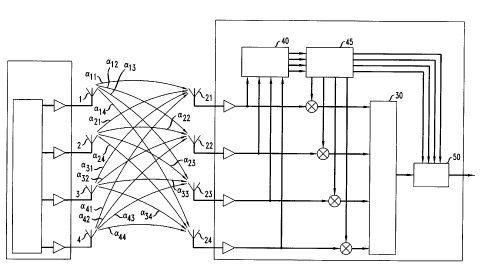Some of the information on this Web page has been provided by external sources. The Government of Canada is not responsible for the accuracy, reliability or currency of the information supplied by external sources. Users wishing to rely upon this information should consult directly with the source of the information. Content provided by external sources is not subject to official languages, privacy and accessibility requirements.
Any discrepancies in the text and image of the Claims and Abstract are due to differing posting times. Text of the Claims and Abstract are posted:
| (12) Patent: | (11) CA 2255464 |
|---|---|
| (54) English Title: | NEAR-OPTIMAL LOW-COMPLEXITY DECODING OF SPACE-TIME CODES FOR FIXED WIRELESS APPLICATIONS |
| (54) French Title: | DECODAGE QUASI OPTIMAL DE COMPLEXITE REDUITE DE CODES ESPACE-TEMPS POUR DES APPLICATIONS FIXES SANS FIL |
| Status: | Deemed expired |
| (51) International Patent Classification (IPC): |
|
|---|---|
| (72) Inventors : |
|
| (73) Owners : |
|
| (71) Applicants : |
|
| (74) Agent: | KIRBY EADES GALE BAKER |
| (74) Associate agent: | |
| (45) Issued: | 2002-08-06 |
| (22) Filed Date: | 1998-12-10 |
| (41) Open to Public Inspection: | 1999-06-23 |
| Examination requested: | 1998-12-10 |
| Availability of licence: | N/A |
| (25) Language of filing: | English |
| Patent Cooperation Treaty (PCT): | No |
|---|
| (30) Application Priority Data: | ||||||
|---|---|---|---|---|---|---|
|
An improved multi-antenna receiver is realized for detecting signals transmitted by a multi-antenna transmitter by summingsumming signals received at the plurality of receiver antennas after multiplying each by a respective constant. The summed signal is applied to a maximum likelihood detector. The respective constants, .lambda.j, where j is an index designating a particular receiver antenna, are determined by evaluating the largest eigenvalue of the matrix AA(A*)T, where A is a vector containing the values .lambda.j, and A is a matrix containing elements .alpha. ij, which is the transfer function between the i th transmitter antenna to the j th receiver antenna. The .alpha. ij terms are determined in the receiver in conventional ways.
Un récepteur multiantennes amélioré sert à détecter des signaux transmis par un récepteur multiantennes en faisant la somme des signaux reçus par la pluralité d'antennes réceptrices après avoir multiplié chacun par une constante respective. Le signal global est appliqué à un détecteur de probabilité maximale. Les constantes respectives j, où j est un indice désignant une antenne réceptrice particulière, sont déterminées en évaluant la valeur propre la plus grande de la matrice A(*)T, où est un vecteur contenant les valeurs j et A est une matrice contenant les éléments ij, qui est la fonction de transfert entre la i-ème antenne émettrice et la j-ème antenne émettrice. Les termes ij sont déterminés dans le récepteur de manière classique.
Note: Claims are shown in the official language in which they were submitted.
Note: Descriptions are shown in the official language in which they were submitted.

For a clearer understanding of the status of the application/patent presented on this page, the site Disclaimer , as well as the definitions for Patent , Administrative Status , Maintenance Fee and Payment History should be consulted.
| Title | Date |
|---|---|
| Forecasted Issue Date | 2002-08-06 |
| (22) Filed | 1998-12-10 |
| Examination Requested | 1998-12-10 |
| (41) Open to Public Inspection | 1999-06-23 |
| (45) Issued | 2002-08-06 |
| Deemed Expired | 2018-12-10 |
There is no abandonment history.
| Fee Type | Anniversary Year | Due Date | Amount Paid | Paid Date |
|---|---|---|---|---|
| Request for Examination | $400.00 | 1998-12-10 | ||
| Registration of a document - section 124 | $100.00 | 1998-12-10 | ||
| Application Fee | $300.00 | 1998-12-10 | ||
| Maintenance Fee - Application - New Act | 2 | 2000-12-11 | $100.00 | 2000-09-27 |
| Maintenance Fee - Application - New Act | 3 | 2001-12-10 | $100.00 | 2001-10-03 |
| Final Fee | $300.00 | 2002-05-16 | ||
| Maintenance Fee - Patent - New Act | 4 | 2002-12-10 | $100.00 | 2002-12-04 |
| Maintenance Fee - Patent - New Act | 5 | 2003-12-10 | $150.00 | 2003-11-05 |
| Maintenance Fee - Patent - New Act | 6 | 2004-12-10 | $200.00 | 2004-11-04 |
| Maintenance Fee - Patent - New Act | 7 | 2005-12-12 | $200.00 | 2005-11-04 |
| Maintenance Fee - Patent - New Act | 8 | 2006-12-11 | $200.00 | 2006-11-07 |
| Maintenance Fee - Patent - New Act | 9 | 2007-12-10 | $200.00 | 2007-11-07 |
| Maintenance Fee - Patent - New Act | 10 | 2008-12-10 | $250.00 | 2008-11-12 |
| Maintenance Fee - Patent - New Act | 11 | 2009-12-10 | $250.00 | 2009-11-10 |
| Maintenance Fee - Patent - New Act | 12 | 2010-12-10 | $250.00 | 2010-11-17 |
| Maintenance Fee - Patent - New Act | 13 | 2011-12-12 | $250.00 | 2011-11-17 |
| Maintenance Fee - Patent - New Act | 14 | 2012-12-10 | $250.00 | 2012-11-15 |
| Maintenance Fee - Patent - New Act | 15 | 2013-12-10 | $450.00 | 2013-11-14 |
| Maintenance Fee - Patent - New Act | 16 | 2014-12-10 | $450.00 | 2014-11-14 |
| Maintenance Fee - Patent - New Act | 17 | 2015-12-10 | $450.00 | 2015-11-13 |
| Maintenance Fee - Patent - New Act | 18 | 2016-12-12 | $450.00 | 2016-11-10 |
Note: Records showing the ownership history in alphabetical order.
| Current Owners on Record |
|---|
| AT&T WIRELESS SERVICES, INC. |
| Past Owners on Record |
|---|
| LO, TITUS |
| TAROKH, VAHID |